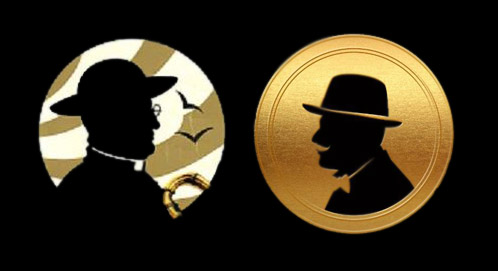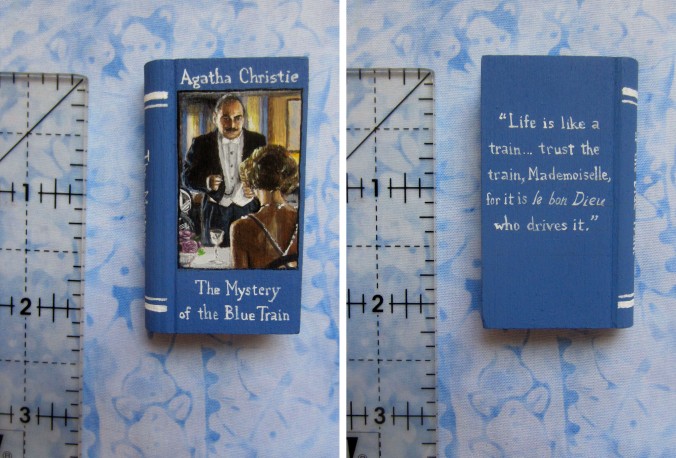***Requisite SPOILER warning*** 🙂
The first detective fiction oeuvre with which I was to become extensively familiar was not Agatha Christie’s. It was the Father Brown stories by G.K. Chesterton. There was an overlap in their crime fiction careers– Chesterton was the first president of the Detection Club, formed in 1930 (with Christie as a member), until his death in 1936. Christie took up the presidential mantle in 1957 until her own death nearly two decades later. In general, there’s no question that Christie imbibed the influence of Chesterton. (Incidentally, Father Brown’s sidekick is a Frenchman named Hercule Flambeau, who has, if you can believe it, some really impressive black moustaches.) In Christie’s delightful and hilarious Partners in Crime, featuring Tommy and Tuppence, the young sleuths decide to solve crimes in the styles of different classic fictional detectives, and a chapter is reserved for Father Brown. In this chapter, Chesterton readers will recognize direct allusions to his stories “The Mistake of the Machine” and “The Invisible Man.”
I remember wondering, the first time that I read The A.B.C. Murders, whether part of the initial idea for the plot was supplied by Chesterton from his story “The Sign of the Broken Sword.” The two stories use similar language and adages to describe the murderer’s ingenious idea of concealing his crime by hiding one particular murder in a group of other murders.
In the great unveiling of The A.B.C. Murders, Poirot says via Christie:
*****
‘What would be the object of writing such letters? To focus attention on the writer, to call attention to the murders! En vérité, it did not seem to make sense at first sight. And then I saw light. It was to focus attention on several murders– on a group of murders… When do you notice a pin least? When it is in a pincushion! When do you notice an individual murder least? When it is one of a series of related murders.’
*****
In the television adaptation, Poirot couches the adage in slightly different terms:
*****
“Where is the best place for a man to hide himself?”
“In a crowd of other men.”
“Yes, Hastings. And where is the best place to conceal a murder?”
“A murder? I don’t know… among a lot of other murders, I suppose.”
“Précisément, Hastings! At Churston, I said that the victims were chosen in a manner that was haphazard, selected only because of their initials, yes? I was wrong, Hastings. All of the victims are haphazard, yes, except for one. This monster is committing a series of murders in order to draw away our attention from one murder in particular!”
*****
And from Chesterton’s “The Sign of the Broken Sword,” we have this…
*****
After the first silence the small man said to the other:
‘Where does a wise man hide a pebble?’
And the tall man answered in a low voice: ‘On the beach.’
The small man nodded, and after a short silence said: ‘Where does a wise man hide a leaf?’
And the other answered: ‘In the forest.’
…
‘Yes; the wise man hides a pebble on the beach. But what does he do if there is no beach?’
…
The priest said again:
‘Where does a wise man hide a leaf? In the forest. But what does he do if there is no forest?’
‘Well– well,’ cried Flambeau irritably, ‘what does he do?’
‘He grows a forest to hide it in,’ said the priest in an obscure voice. ‘A fearful sin.’
…
‘…If there were no forest, he would make a forest. And if he wished to hide a dead leaf, he would make a dead forest.’
There was still no reply, and the priest added still more mildly and quietly:
‘And if a man had to hide a dead body, he would make a field of dead bodies to hide it in.’
*****
Some weeks ago, I ran across a more direct reference to this same Father Brown story in The Clocks! I have no idea how I could have missed it. For those of you who are more familiar with the Poirot television series, you might remember that at the beginning of Third Girl (as in the book), Poirot is sitting at the breakfast table, contemplating a book. It is his own work, an analysis of crime fiction. As it happens, in The Clocks (the Poirot story directly before Third Girl), the detective has begun to seriously study crime fiction, preparatory for that future book, and holds forth on the subject at some length to Colin Lamb. “The Sign of the Broken Sword” is explicitly mentioned in the denouement.
*****
Poirot went on:
‘It is, as it were, the opposite of Chesterton’s, “Where would you hide a leaf? In a forest. Where would you hide a pebble? On a beach.” Here there is excess, fantasy, melodrama! When I say to myself in imitation of Chesterton, “Where does a middle-aged woman hide her fading beauty?” I do not reply, “Amongst other faded middle-aged faces.” Not at all…’
*****
Not only is Christie familiar with Chesterton’s story and that memorable, monstrous criminal notion, but Poirot is, too! The idea of hiding one significant murder among several other “decoy” murders is, perhaps, not original to Chesterton, but I think that his story, with its haunting language and broody atmosphere, clearly stayed in Christie’s crime-writing consciousness. She seems to be willing to attribute the idea to him. Could it have been the spark that had eventually led to The A.B.C. Murders? I don’t deny Christie’s ingenuity– she used that idea in a wonderfully inventive and original way in what would become one of her very best, most memorable novels. But in light of those striking adages, and Christie’s own familiarity with “Broken Sword,” I’m convinced that there is a tip of the hat to offer to Chesterton’s Father Brown there. 🙂






